Java development in 2024 has taken leaps toward innovation, and choosing the best Java development environment is more crucial than ever for developers. Java developers unlock a suite of advanced features designed to streamline the development process, from code completion to syntax highlighting. This ensures every piece of Java code runs efficiently on the Java Virtual Machine and adheres to the highest code quality standards.
Aloa, an expert in software outsourcing, emphasizes the importance of an integrated development environment (IDE) that offers advanced features. These tools significantly help new Java developers while optimizing the development process. Aloa recommends IDEs that prioritize ease of use, comprehensive code editing and debugging tools, and robust project management capabilities to streamline software development.
Based on our insights and extensive research, we've crafted this guide to delve into the best Java IDE options for 2024. Here, we’ll highlight the top IDEs, explore their notable features, and learn about the factors that make the best Java development environment. Afterward, you'll find out the features and capabilities that define the best Java IDE for web applications, Java SE, and beyond, ensuring your development process is as efficient and innovative as Java.
Let's dive in!
What is a Java Development Environment?
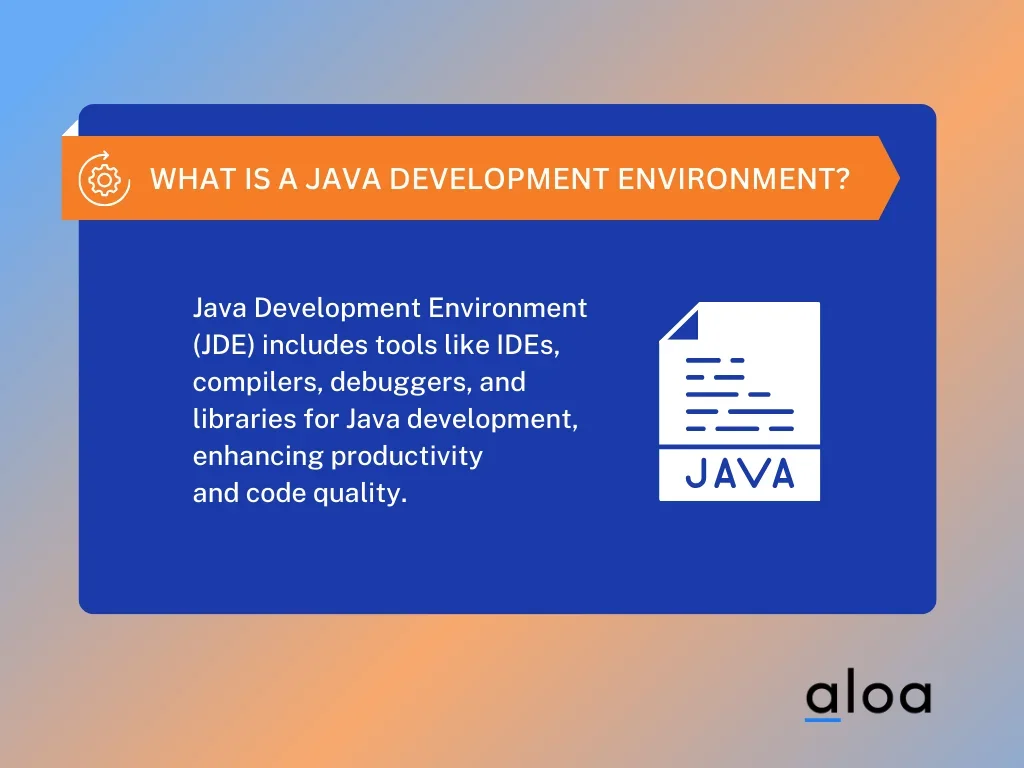
Java Development Environment refers to the set of tools and resources utilized for software development in Java. It encompasses IDEs, compilers, debuggers, and libraries. The best Java development environment facilitates seamless coding, debugging, and testing. These environments offer features like auto-completion, syntax highlighting, and integrated debugging, making them indispensable for Java development.
The best Java development environment offers numerous benefits, including enhanced developer productivity, streamlined workflows, and improved code quality. Developers can leverage advanced features such as code refactoring, auto-completion, and intelligent debugging tools to expedite development cycles and minimize errors.
8 Best Java Development Environment Options for 2024
In 2024, Java developers will have an array of development environments (IDEs) to choose from, each offering unique features tailored to streamline coding workflows and enhance productivity. Let's explore eight of the best Java development environment options available in 2024, highlighting their key features and functionalities.
1. IntelliJ IDEA - Best for Enterprise Development
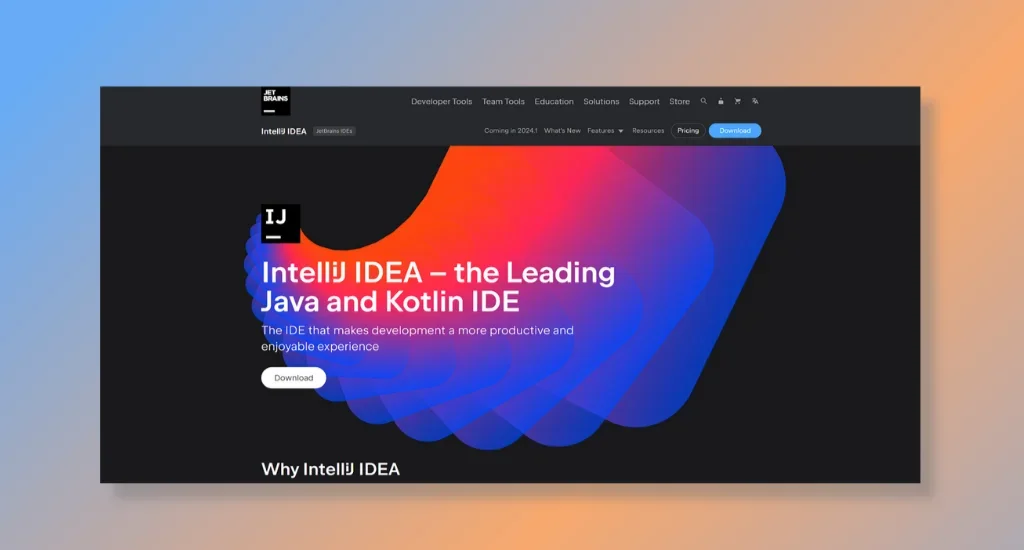
IntelliJ IDEA is the best Java development environment, offering unparalleled support for Java and Kotlin. Its deep understanding of code makes development more productive and enjoyable. With features like smart completion and framework-specific assistance, IntelliJ IDEA ensures developers stay ahead with cutting-edge language features.
What makes IntelliJ IDEA unique is its seamless integration of essential tools without requiring additional plugins. Its AI Assistant enhances productivity with AI-powered code generation and modification, a feature few others offer.
Notable Features of Using IntelliJ IDEA
- Smart Completion: Offers code completion suggestions based on the most relevant context, significantly speeding up the coding process.
- Framework-Specific Assistance: Provides specialized support for various frameworks, including Spring and Jakarta EE, simplifying project setup and maintenance.
- Integrated Development Tools: Comes with built-in tools for database support, version control, and deployment, offering a unified development experience.
- AI Assistant: Enhances developer productivity with features like AI-powered code suggestions and project-related queries unique to IntelliJ IDEA.
IntelliJ IDEA Pricing Plans
IntelliJ IDEA offers a variety of pricing plans:
- Individual Use: Starting at $599/year for the first year, with discounts for subsequent years.
- For Organizations: Customized pricing is available upon request.
- All Products Pack: Includes IntelliJ IDEA and other JetBrains tools, starting at $779/year for the first year.
Businesses of all sizes, especially enterprises involved in Java and Kotlin development, benefit the most from IntelliJ IDEA. Its comprehensive toolset and AI-enhanced features cater to the needs of developers looking for a robust, efficient, and intuitive Java development environment.
2. Eclipse IDE - Best for Plug-in Development
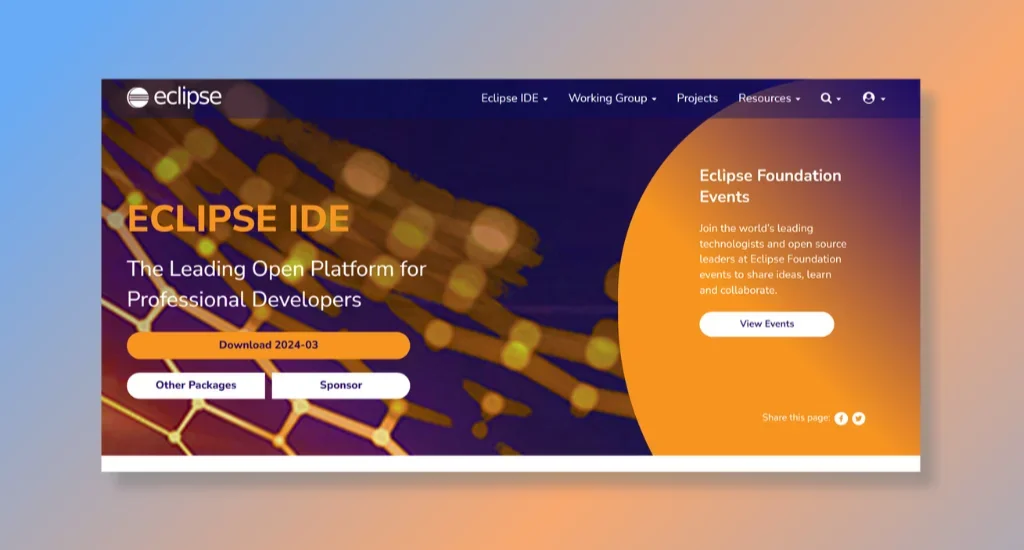
Eclipse IDE excels as the best Java development environment for plug-in development, courtesy of its proven extensibility. It excels with a vast array of platform plugins, easing the addition of new functionalities. Specializing in facilitating seamless plug-in integration, Eclipse IDE offers developers a flexible and customizable development experience, enabling them to tailor the IDE to their needs.
Eclipse IDE's uniqueness lies in its robust plug-in development tooling. It supports and provides classpath fixes for bnd projects and offers comprehensive declarative services support. These features are unparalleled, offering something few others on the list provide, positioning Eclipse IDE at the forefront of plug-in development environments.
Notable Features of Using Eclipse IDE
- Proven Extensibility: With a vast ecosystem of plugins, Eclipse IDE allows for easy expansion and customization.
- Improved Plug-in Development Tooling: Offers robust support for bnd projects and declarative services, streamlining plug-in development.
- Free and Open Source: Released under the Eclipse Public License 2.0, it provides a cost-effective solution for developers.
- Community-Powered: Benefits from contributions by a global community, ensuring continuous improvement and support.
Eclipse IDE Pricing Plans
Eclipse IDE is a free and open-source project:
- No Cost: Completely free for use by individuals and enterprises.
- Open Source License: Released under the Eclipse Public License 2.0.
Plug-in developers and organizations focusing on extending their development tools benefit most from the Eclipse IDE. Its comprehensive support for plug-in development and its vast, community-driven ecosystem of plugins make it the ideal Java development environment for creating custom development solutions.
3. Visual Studio Code - Best for Lightweight Java Development
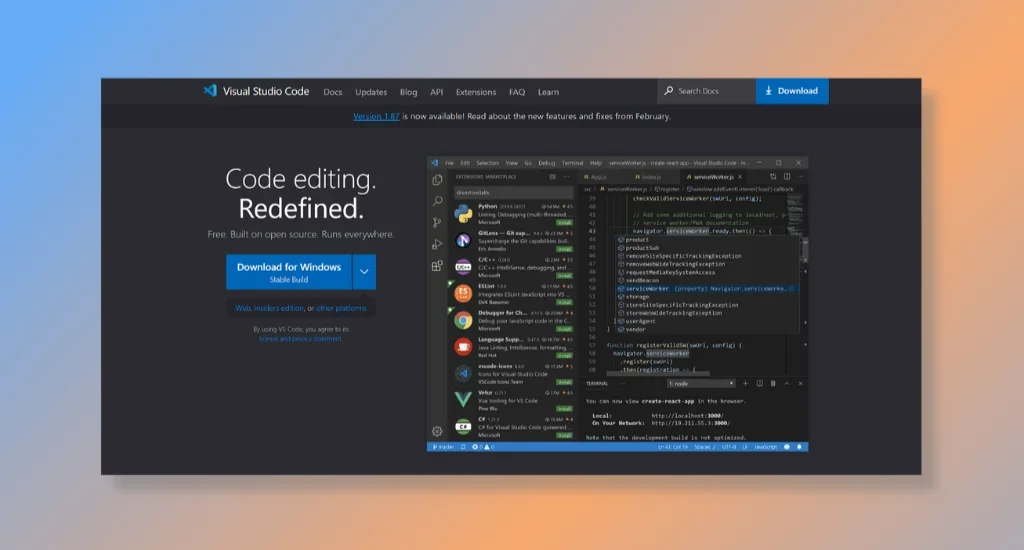
Visual Studio Code (VS Code) emerges as the best lightweight Java development environment, ideal for developers seeking a versatile and efficient editor. It has a quick setup and seamless operation, particularly with extensions for Maven, Tomcat, Jetty, and Spring Boot. This setup delivers a comprehensive development experience, from code editing and debugging to project management and version control, all within a single, lightweight package.
VS Code has unique features such as GitHub Copilot for AI-assisted code completion and IntelliSense for smarter code suggestions. Moreover, VS Code's remote development and collaboration support through Visual Studio Live Share positions it as a highly adaptable tool for modern development practices, catering to teams and solo developers alike.
Notable Features of Using Visual Studio Code
- GitHub Copilot: Offers AI-powered code suggestions and completion, significantly speeding up development and enhancing code quality.
- IntelliSense: Delivers intelligent code completion and suggestions tailored to Java development, improving efficiency and accuracy.
- Remote Development: Supports development on remote servers or containers, enabling a flexible and scalable development environment.
- Live Share: Facilitates real-time code collaboration with team members, regardless of location, fostering teamwork and streamlining development processes.
Visual Studio Code Pricing Plans
Visual Studio Code is free and open, making it an accessible choice for developers worldwide.
Individual developers, small teams, and educational institutions stand to benefit most from Visual Studio Code. Its versatility and extensive support for various programming languages and frameworks make it an ideal choice for those starting their Java journey or working on projects that span multiple technologies.
4. Apache NetBeans - Best for Cross-Platform Java Development
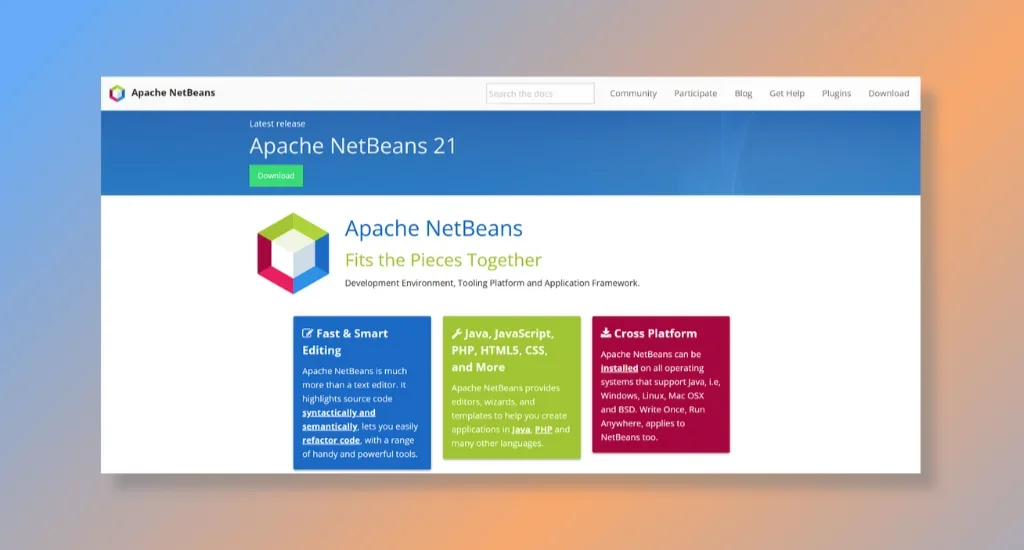
Apache NetBeans is the best Java development environment for cross-platform development. It supports many programming languages beyond Java, including PHP, HTML5, CSS, and JavaScript. This IDE provides fast and smart editing capabilities, making code refactoring and semantic highlighting efficient and straightforward.
What makes Apache NetBeans unique is its extensive support for both desktop and web applications across various operating systems such as Windows, Linux, macOS, and BSD. This universal compatibility ensures that developers can work on their projects regardless of the platform, embodying the "Write Once, Run Anywhere" principle.
Notable Features of Using Apache NetBeans
- Fast and Smart Editing: Offers advanced code completion, refactoring, and semantic highlighting.
- Multi-Language Support: Enables development in Java, JavaScript, PHP, HTML5, and CSS, among others.
- Cross-Platform Compatibility: Runs on any operating system supporting Java, ensuring your development workflow flexibility.
- Community and Support: Backed by a strong community, NetBeans offers extensive documentation, tutorials, and support channels.
Apache NetBeans Pricing Plans
Apache NetBeans is an open-source project and is available free of charge. This makes it an accessible choice for individual developers, educational institutions, and commercial firms.
Developers from diverse backgrounds, especially those working on cross-platform applications, will find Apache NetBeans invaluable. Its comprehensive feature set caters to various development tasks, from simple desktop applications to complex web services.
5. Oracle JDeveloper - Best for Full Lifecycle Java EE Development
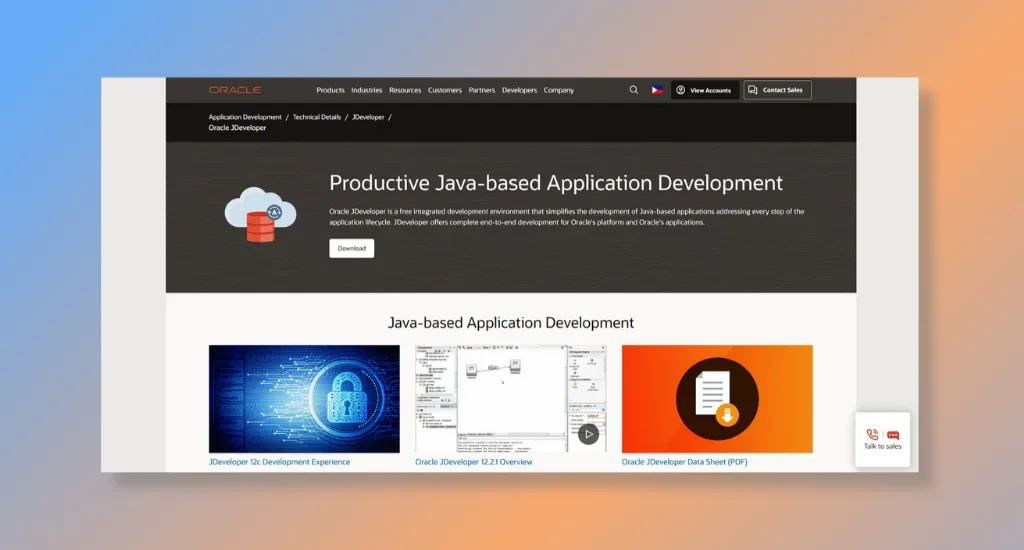
Oracle JDeveloper is recognized as the best Java development environment for full-lifecycle Java EE development, streamlining the entire development process from design through deployment. It provides a comprehensive toolset that supports direct integration with Oracle's platform and applications, making it exceptionally suited for developers within the Oracle ecosystem.
Unique to JDeveloper are its end-to-end development capabilities, enabling developers to manage their entire project lifecycle within a single environment. This integration extends to Oracle's cloud services and applications, providing a unified platform for Oracle-based development.
Notable Features of Using Oracle JDeveloper
- End-to-End Development Support: Offers tools that cover every aspect of the application lifecycle, from design to deployment, within a single environment.
- Oracle ADF Integration: Provides deep integration with Oracle ADF, enabling rapid and efficient application development with a visual and declarative development experience.
- Comprehensive Oracle Integration: Seamlessly integrates with Oracle's platform and applications, offering a unified development experience for Oracle developers.
- Free and Comprehensive Toolset: As a free integrated development environment, JDeveloper includes a broad array of Java EE development tools without additional plugins.
Oracle JDeveloper Pricing Plans
Oracle JDeveloper is free, offering a complete set of development tools without subscription or licensing fees.
Organizations developing Oracle-based applications or working extensively with Java EE stand to benefit most from Oracle JDeveloper. It has a comprehensive toolset, seamless integration with Oracle technologies, and support for the full application lifecycle.
6. BlueJ - Best for Java Beginners
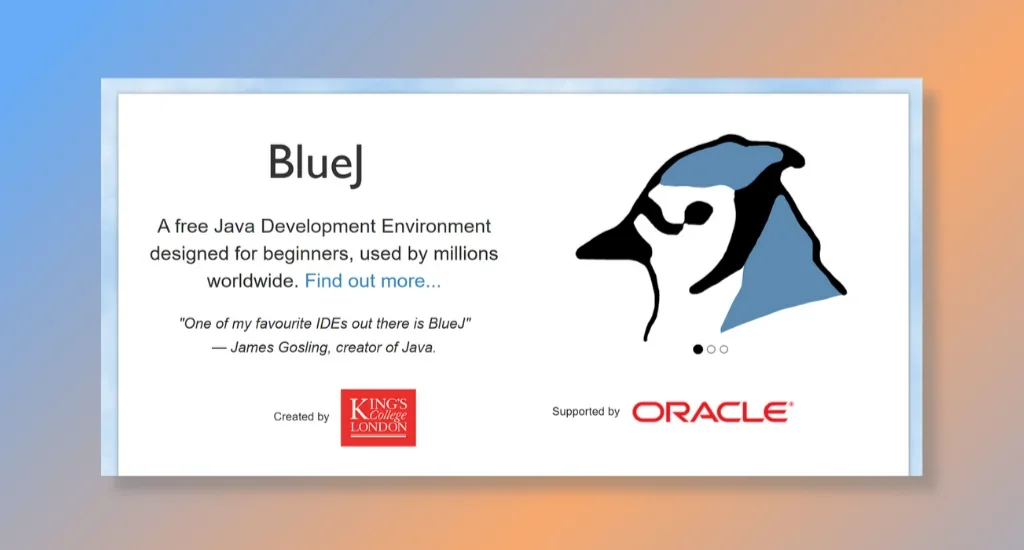
BlueJ is the best Java development environment for beginners, with millions of users worldwide. Endorsed by James Gosling, the creator of Java, it is celebrated for its simplicity and effectiveness in learning. As a Java DE developed by King's College London and supported by Oracle, it provides a user-friendly interface that helps newcomers navigate the complexities of Java programming.
It offers features tailored for teaching, such as object interaction without compilation and dynamic method invocation, setting it apart from other development environments. Its interactive nature allows users to experiment with Java expressions directly, fostering a hands-on learning experience. Additionally, its support for Windows and Mac OS X and its portability ensures wide accessibility.
Notable Features of Using BlueJ
- Scope Highlighting: Enhances code readability by coloring the background of code blocks, aiding faster visual navigation.
- Object Inspection: Allows real-time inspection of objects during program execution, facilitating understanding and debugging.
- Interactive Execution: Enables the direct invocation of Java code without the need for compilation, promoting exploratory learning.
- Portability: It can run on multiple platforms and from USB sticks without installation, making it accessible anywhere.
BlueJ Pricing Plans
BlueJ is freely available under the GNU General Public License version 2, making it an excellent resource for individuals and educational institutions.
Educational institutions, teachers, and students stand to benefit most from BlueJ. Its design caters specifically to those new to programming or teaching introductory programming courses.
7. jGRASP - Best for Visualizing Data Structures and Algorithms
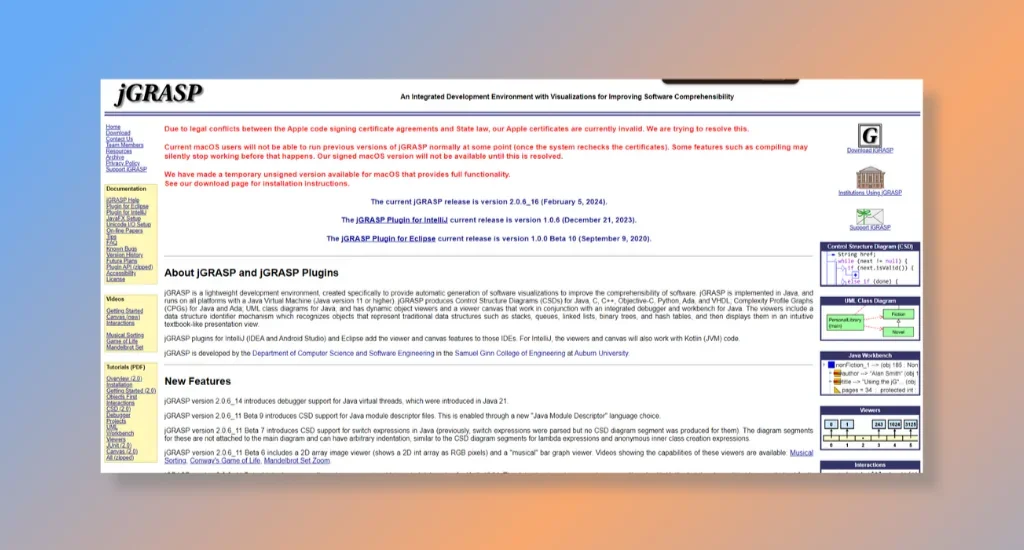
jGRASP emerges as the best Java development environment for visualizing data structures and algorithms. It specializes in enhancing software comprehensibility through the automatic generation of software visualizations. With that, developers excel in creating intuitive, textbook-like presentations of traditional data structures like stacks, queues, linked lists, binary trees, and hash tables through Control Structure Diagrams (CSDs) and viewer canvases.
What makes jGRASP unique is its comprehensive support for various programming languages and its ability to integrate with popular IDEs like IntelliJ IDEA and Eclipse via plugins. Additionally, its support for virtual thread debugging in Java 21 sets it apart, showcasing its commitment to keeping pace with the latest developments in Java technology.
Notable Features of Using jGRASP
- Control Structure Diagrams (CSDs): Automatically generate diagrams for Java, C, C++, and other languages, improving code comprehensibility.
- Viewer Canvas: Identifies data structures in the code and displays them intuitively, making it easier to understand and debug complex structures.
- Integrated Debugger with Virtual Threads Support: Offers advanced debugging capabilities, including support for Java 21's virtual threads, facilitating modern Java development.
- Plugin Integration: Enhances IntelliJ IDEA and Eclipse with jGRASP's visualization capabilities, allowing for a seamless development experience across environments.
jGRASP Pricing Plans
jGRASP is a product of Auburn University and is available for free. It aims to improve software comprehensibility without adding financial burden to users.
Educational institutions and individuals focusing on understanding and teaching complex data structures and algorithms benefit most from jGRASP. Its unique visualization features cater to those looking to deepen their comprehension of software behavior and structure, making it an indispensable tool in academic and research settings.
8. Anjuta - Best for Advanced Debugger
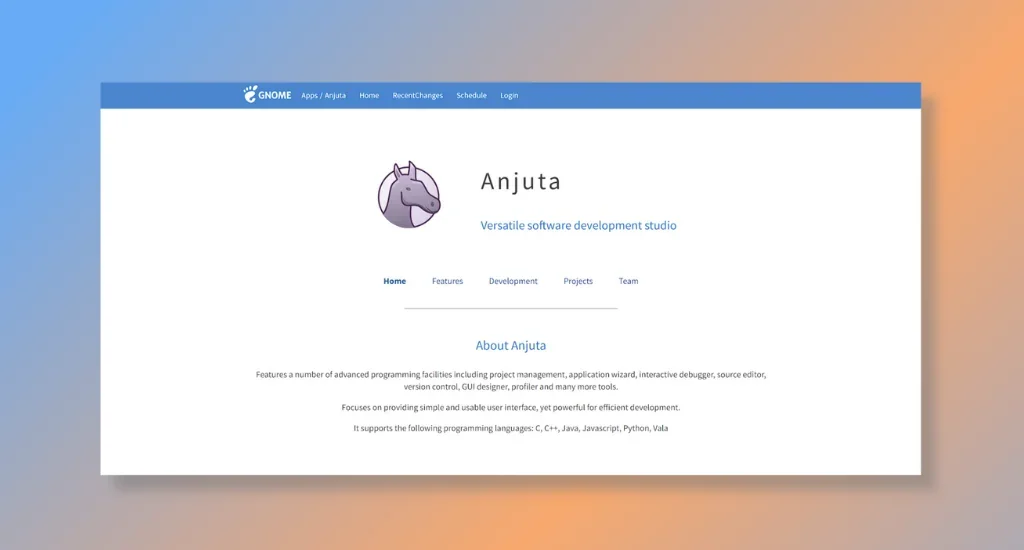
Anjuta stands out for its versatile software development studio tailored for Java projects. It provides various advanced programming facilities, including project management, interactive debugger, source editor, version control, GUI designer, and profiler. Anjuta focuses on delivering a simple yet powerful user interface that is efficient for Java development tasks.
Additionally, it offers a flexible and advanced docking system, extensive plugin support for customization, and efficient file management capabilities. Anjuta's integration with Glade for user interface design and Devhelp for API documentation browsing adds further value to Java developers.
Notable Features of Using Anjuta
- Advanced Debugger: Anjuta provides a full source-level debugger, ensuring comprehensive debugging support for Java projects.
- Integrated Glade Designer: With an integrated Glade User Interface Designer, Anjuta simplifies the creation of Java GUIs, enhancing development efficiency.
- Devhelp Integration: Anjuta seamlessly integrates Devhelp API Help Browser, offering instant access to Java API documentation within the IDE.
- Flexible Project Management: Anjuta's project manager plugin supports various project structures, making it adaptable for Java projects of different complexities.
Anjuta Pricing Plans
Anjuta is an open-source IDE that is available for free to all users. There are no pricing plans as it is developed and maintained by the open-source community.
Anjuta mainly benefits Java developers seeking a simple yet powerful development environment. Its versatility suits individual developers and small to medium-sized software development teams focusing on Java application development.
Key Features to Look for in the Best Java Development Environment
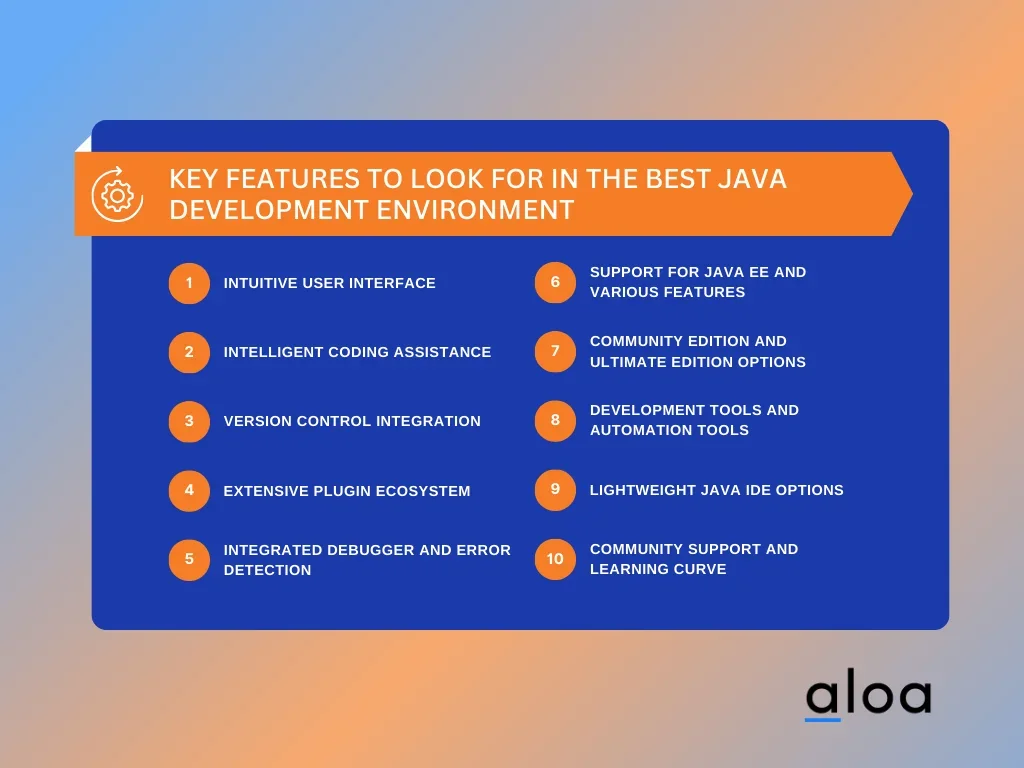
Several critical features stand out when searching for the best Java development environment. These elements not only enhance your coding experience but also streamline development tasks. Here's what to prioritize:
- Intuitive User Interface: The ideal Java IDE offers an intuitive interface, making navigation and code editing seamless for developers.
- Intelligent Coding Assistance: Features like autocomplete and intelligent code navigation significantly speed up the development process for Java applications.
- Version Control Integration: A top Java development environment seamlessly integrates with version control systems, like Git, ensuring efficient project management.
- Extensive Plugin Ecosystem: With an extensive plugin ecosystem, developers can customize the IDE to suit their needs, from web development to Android studio projects.
- Integrated Debugger and Error Detection: These tools are essential for identifying and resolving issues quickly, making them indispensable for any good Java IDE.
- Support for Java EE and Various Features: The best Java development environment offers comprehensive support for Java Enterprise Edition and a wide range of features for both web and large projects.
- Community Edition and Ultimate Edition Options: Whether you opt for a free trial or the full suite, options like IntelliJ IDEA provide versatility for all developers.
- Development Tools and Automation Tools: Effective automation tools facilitate smooth development cycles for Java programs.
- Lightweight Java IDE Options: A lightweight Java IDE like VS Code ensures quick setup and is ideal for smaller projects, offering a good balance between functionality and resource usage.
- Community Support and Learning Curve: Adequate community support can ease the learning curve, especially when navigating the complexities of the Java programming language for the first time.
Key Takeaway
Selecting an IDE that aligns with a developer's needs and project requirements is crucial in finding the best Java development environment. This choice can significantly influence productivity, code quality, and project success. The Java IDEs offer intuitive design, robust features, and seamless integration with other tools, ensuring developers can focus on creating efficient and error-free code.
Startups and businesses must carefully consider their choice of Java development environment. The suitable IDE can accelerate development cycles, enhance team collaboration, and support agile methodologies. With the right pick of the best Java development environment, you can achieve rapid growth, adaptability, and long-term sustainability for your Java projects.
Sign up for Aloa's email list to stay informed about the latest trends and updates in the best Java development environment. You’ll gain exclusive access to insights, tips, and recommendations that can guide you in choosing the ideal environment based on your needs. With Aloa's expertise and resources, developers and businesses aiming to enhance productivity and project outcomes can gain a competitive edge in the tech landscape.

